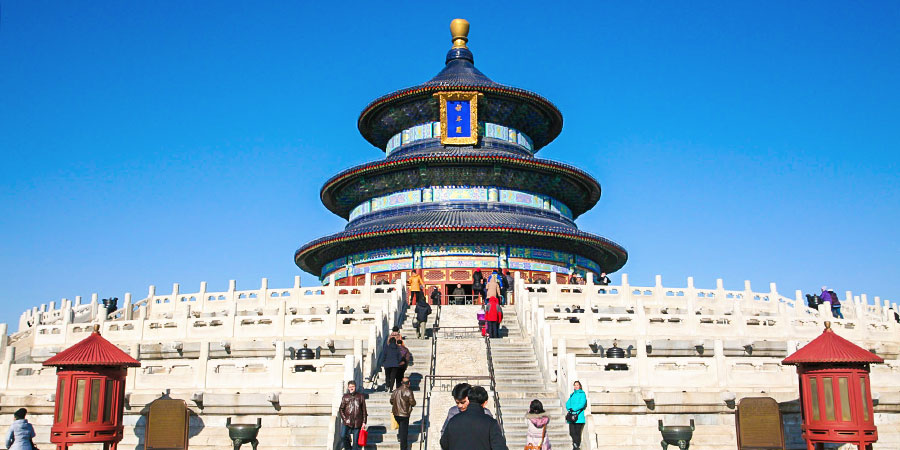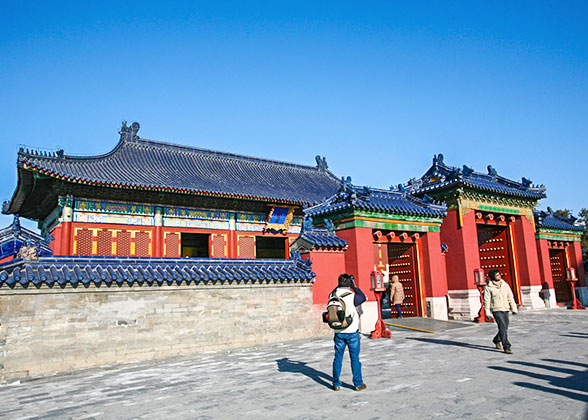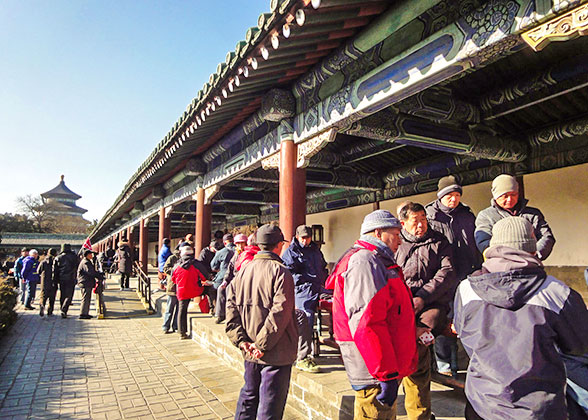The Altar of Prayer for Good Harvests is located in the northern part of the Temple of Heaven Park, where in ancient times the emperors held worship ceremonies to pray for good weather and abundant harvests. Built in 1420, the 18th year of the reign of Emperor Yongle of the Ming Dynasty (1368 - 1644), the Altar of Prayer for Good Harvests is the earliest building complex of the Temple of Heaven. It consists of two main buildings, namely the Hall of Prayer for Good Harvests and the Imperial Hall of Heaven; and several subsidiary buildings including the Long Corridor, the Dressing Terrace, the Danbi Bridge, the Divine Kitchen, the Butcher Pavilion, the Seven Star Stone, etc.

The Hall of Prayer for Good Harvests is a circular building which is 32 meters (105 feet) in diameter and 38 meters (125 feet) high, sitting on a huge round white marble platform named Altar for Grain Prayers. Covering over 5,900 square meters (64,000 square feet), the altar has a height of six meters, consisting of three floors; each of which is surrounded by carved white marble railings. The stairs connecting each floor are decorated with huge relief.The Hall of Prayer for Good Harvests has three layers of eaves; each layer is covered with blue colored glaze symbolizing the heaven. The layer-by-layer eave creates an atmosphere of getting closer to heaven.
The Hall of Prayer for Good Harvests is a masterpiece of wood frame construction. Inside the hall there is no beam, but 28 Phoebe columns and 36 pieces of interconnected squared rafters. These large columns have different symbolic meanings: The four posts along the inner circle represent the four seasons - spring, summer, autumn and winter; the 12 posts along the middle circle represent the 12 months; and the 12 along the outer circle represent 12 Shichen (an ancient Chinese timing unit equaling two hours). The ceiling and the columns are decorated with fine colorful paintings. In the central hall, there is a flat circular marble with naturally formed dragon and phoenix patterns, and the name "dragon and phoenix stone" was thus given. According to legend, originally the stone only had a phoenix pattern, while there was a dragon pattern on the ceiling. As time went by, the dragon and the phoenix fell in love with each other. The dragon always flew down to date with the phoenix. Unexpectedly, one day, Emperor Jiajing (1507-1567) of the Ming Dynasty held a worship ceremony in the hall, and knelt down on the stone. It was too late for the dragon to fly back and it was pressed into the stone forever. Today you can see the dragon and the phoenix together on the stone. Standing in the middle of the hall, the Sacred Altar is the most sacred part, on which the Heaven Great Tablet is placed. On the eastern and western sides of the Sacred Altar stand four ancestral tablets of Qing Dynasty (1644 - 1911) respectively.
On the two sides of the Hall of Prayer for Good Harvests are the West Annex Halls and the East Annex Halls. The two annex halls used to be the storeroom of divine tablets. Now the West Annex Halls are set as a Worshipping Heaven Ceremony Exhibition Hall, displaying sacrificial utensils and the whole procedure about worshipping heaven by the emperor. There is an excellent picture about Emperor Qianlong (1711-1799) showing the highest ritual in the Qing Dynasty. The East Annex Halls are now changed into a Worshipping Music and Dancing Hall, exhibiting Shao Music instruments, such as bells and chimes. By means of text description, pictures, light boxes, models, sound and electricity, etc., the music and dancing scene of the ceremony is vividly demonstrated to the visitors.
Imperial Hall of Heaven
Another important main building in this area is the Imperial Hall of Heaven, which is located to the north of the Hall of Prayer for Good Harvests, connecting with the Altar for Grain Prayers by three glaze doors. It used to be the place where God tablets were consecrated. The gate on the west side is called the Guxi Gate (Guxi means seventy years old). The roof of the hall is covered with blue colored glaze. Under the eave, there is a board reading "the Imperial Hall of Heaven" inscribed by Emperor Jiajing. Inside the hall, there are house-shaped shrines holding god tablets. On the first and fifth day of each lunar month, officials would sweep the dust and burn the incense there. The emperor would give a ritual there on the eve of the Ceremony of Worshipping Heaven.
 | | Imperial Hall of Heaven | |  | | Long Corridor | |
Long Corridor
The long corridor is situated east to the Altar for Grain Prayers, stretching out by five meters (16 feet) wide, 350 meters (1,150 feet) long. It consists of 72 rooms sharing the same back wall, roof and eave; hence it is also called the Seventy-Two Corridor. On the eve of the sacrificial ceremony, the corridor was lit up by lanterns and all the offerings, including jade, silk, grains and fruits were transported to the altars along the Long Corridor. There are colorful pictures on the top of the porch. Benches are set between the pillars. It is an enclosed passage connecting the Butcher Pavilion, the Divine Kitchen and the Divine Warehouse. To the South of the corridor stands the Seven Star Stone, on which various patterns are engraved. The stone with a history of 500 years was artificially made in the time of Emperor Jiajing.
 Next: Palace of Abstinenc
Next: Palace of Abstinenc
- Last updated on Dec. 19, 2023 by Kate Liu -
![]() Next: Palace of Abstinenc
Next: Palace of Abstinenc

